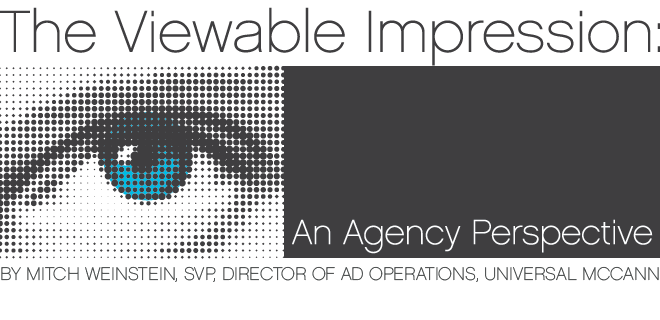
The Viewable Impression is all the rage lately. It’s been blogged about, discussed in private industry meetings, debated on conference panels, and included in client planning decks. The concept makes perfect sense: eliminate all the wasted impressions, and pay for only those that are in view of the user’s browser. Remove the chaff from the media plan and focus on the quality placements that will most effectively drive performance. And once advertisers realize they are getting better quality, they will be more likely to shift larger and larger budgets to Digital.
Unfortunately, the practice of measuring Viewable impressions is a lot more complicated than the concept. The biggest hurdle is the ability, or lack thereof, to see through cross-domain iFrames. iFrames are used widely across the internet to help websites manage multiple pieces of content from different sources within a single page, while ensuring optimal load times and a good user experience. Currently, some companies claim the ability to see through iFrames, and others dispute that this is even technically possible. Lawsuits have been filed, and competitors are accusing each other of exaggerating their technical capabilities. As more and more ad tech firms claim Viewability as one of their core competencies, the potential for noise and confusion increases.
Regardless of where the truth may lie, the fact is different companies are reporting on widely varying data points around what impressions are even measurable, let alone viewable (Measurability is calculated as the rate at which Viewability can be determined, with Viewability being the percentage of those measureable ads that are actually in view). Counting methodologies are different, and reported data does not even come close to being consistent. It’s reminiscent of how we counted impressions and clicks in the late 90s.
In recent testing, the MRC (Media Rating Council) has found a wide range of data on Measurability. They saw huge differences between technology vendors on the impressions that were Measurable, even after reconciling for the different types of placements and media partners, which included multiple ad sizes running on premium publishers and ad networks. The differences were too wide to simply write it off as a standard discrepancy.
In spite of the counting issues, there is little doubt that the Viewable Impression is going to be a cornerstone of our industry in the near future. As the concept of Viewable matures, and gains traction, standards will be developed, finalized, and approved, and more consistent data will become the norm. We’ve seen this with standard impressions, as the major ad servers went through audits and accreditation, and we will see this again around the Viewable Impression. The MRC has begun to accredit some measurement companies for Viewable, and this will continue as momentum grows.
In preparation for Viewable, agencies should begin testing (if they are not already) the different technology companies, and carefully reviewing the data while starting to build benchmarks. Understanding that the data is far from perfect at this point, it still makes sense to get a rough idea of how much of your media is Viewable on a publisher-by-publisher basis. Comparing the data to publisher counts can also help in determining the overall validity of the data. As always, agencies should inform publishers that they are conducting such testing (avoid Ad Ops surprises).
For publishers, it makes sense to start looking at their inventory and perform a thorough analysis of the ad units that are in view vs. those that are not. The concept of Viewable will no doubt greatly impact a website’s inventory availability, and have a big effect on its revenue yield. Peter Naylor, of NBCUniversal, in a recent AdAge article warned publishers to quickly prepare for Viewable or risk a “painful fate.”
However, until such time where methodologies and technologies become more consistent through audits and certifications, it will be difficult to use the Viewable count as the basis for billing. In the meantime, the publishers and agencies getting an early jump on the technology will set the pace and tone for the rest of the industry.
Reprinted from the Universal McCann “Curiosity Works” blog with permission.